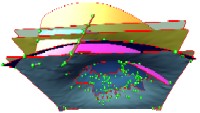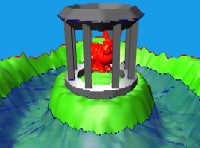|
|
The fairing framework
The pipeline used to remove high frequencies from models is described by the following
pipeline:
 The removal of high frequencies from a non-manifold models is computed in three steps.
The removal of high frequencies from a non-manifold models is computed in three steps.
- First, an approximation of the Laplacian is computed for each vertex in the model.
Note that more than a Laplacian might be computed per vertex: a vertex that lies on an
intersection possesses both a 1D and a 2D Laplacian.
Any existing operator can be used to this end, such as the
umbrella , the
improved umbrella , the
curvature flow and the
second order difference operators.
- The approximation computed in the previous step is then used a second step to compute
the vertex displacement. This operator has the goal of removing high frequency from meshes
while preserving the topology of the model, and guaranteeing cross-intersection smoothness.
This can be formulated as an overdermined system of equations, which can be solved by
minimizing either the 2- or infinite norm.
The minimization of the two norm yealds the algebraic solution:

- Optionally, a volume preserving step can be added to the pipeline, which guarantees local
volume preservation of the model. The concept of locality is very important, since a model
possesses many volumes, and thus global strategies are not applicable. The basic idea is simple:
the displacement of a vertex causes a change in volume, which can be computed efficiently.
This change can be compensated by displacing the neighbor vertices in the opposite direction.
This operation can be computed using one of three different operators, which trade off quality
and robustness for speed.
The local volume preservation operator is visualized by the following set of figures:




The result of the fairing process is dependent on the underlaying model semantics, as discussed in the
data structure section. The following example shows the results of the fairing operator applied to the
same model using different semantics:



 We used our operators on larger models as well: here are a few examples generated from geoscience models
as well as from syntetic data:
We used our operators on larger models as well: here are a few examples generated from geoscience models
as well as from syntetic data:




|
 Overview
Overview  Data structure
Data structure  Fairing
Fairing  Multiresolution
Multiresolution  Subdivision
Subdivision  Feature Extraction
Feature Extraction  Publications
Publications 












